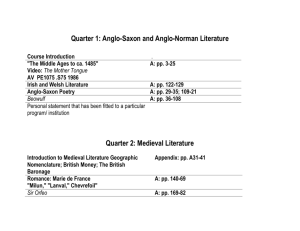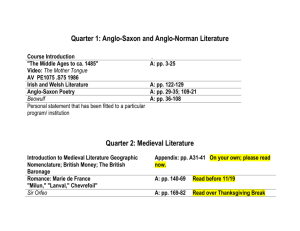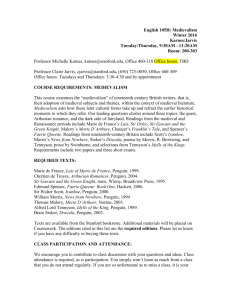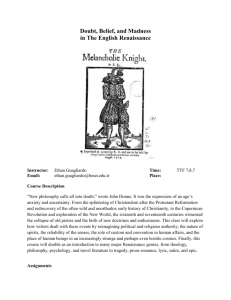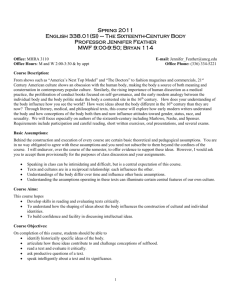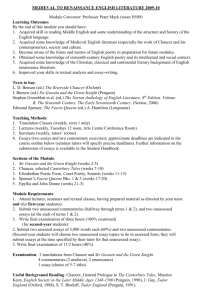The Texts of Edmund Spenser`s The Faerie Queene: Greg - So-net
advertisement
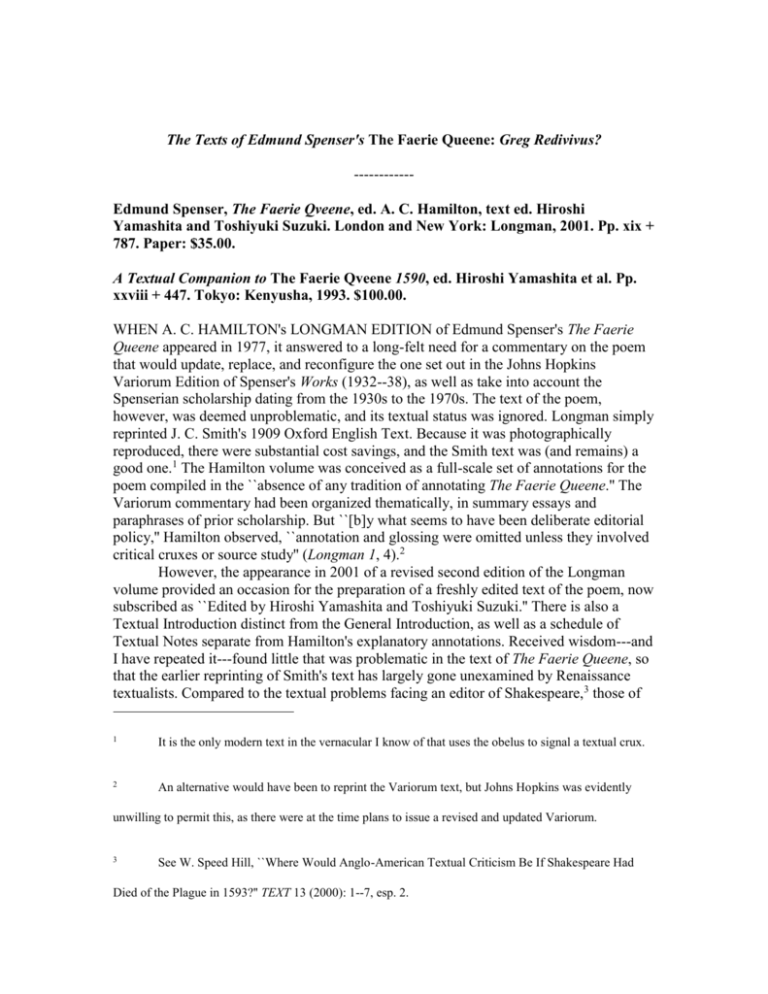
The Texts of Edmund Spenser's The Faerie Queene: Greg Redivivus? -----------Edmund Spenser, The Faerie Qveene, ed. A. C. Hamilton, text ed. Hiroshi Yamashita and Toshiyuki Suzuki. London and New York: Longman, 2001. Pp. xix + 787. Paper: $35.00. A Textual Companion to The Faerie Qveene 1590, ed. Hiroshi Yamashita et al. Pp. xxviii + 447. Tokyo: Kenyusha, 1993. $100.00. WHEN A. C. HAMILTON's LONGMAN EDITION of Edmund Spenser's The Faerie Queene appeared in 1977, it answered to a long-felt need for a commentary on the poem that would update, replace, and reconfigure the one set out in the Johns Hopkins Variorum Edition of Spenser's Works (1932--38), as well as take into account the Spenserian scholarship dating from the 1930s to the 1970s. The text of the poem, however, was deemed unproblematic, and its textual status was ignored. Longman simply reprinted J. C. Smith's 1909 Oxford English Text. Because it was photographically reproduced, there were substantial cost savings, and the Smith text was (and remains) a good one.1 The Hamilton volume was conceived as a full-scale set of annotations for the poem compiled in the ``absence of any tradition of annotating The Faerie Queene.'' The Variorum commentary had been organized thematically, in summary essays and paraphrases of prior scholarship. But ``[b]y what seems to have been deliberate editorial policy,'' Hamilton observed, ``annotation and glossing were omitted unless they involved critical cruxes or source study'' (Longman 1, 4).2 However, the appearance in 2001 of a revised second edition of the Longman volume provided an occasion for the preparation of a freshly edited text of the poem, now subscribed as ``Edited by Hiroshi Yamashita and Toshiyuki Suzuki.'' There is also a Textual Introduction distinct from the General Introduction, as well as a schedule of Textual Notes separate from Hamilton's explanatory annotations. Received wisdom---and I have repeated it---found little that was problematic in the text of The Faerie Queene, so that the earlier reprinting of Smith's text has largely gone unexamined by Renaissance textualists. Compared to the textual problems facing an editor of Shakespeare,3 those of 1 It is the only modern text in the vernacular I know of that uses the obelus to signal a textual crux. 2 An alternative would have been to reprint the Variorum text, but Johns Hopkins was evidently unwilling to permit this, as there were at the time plans to issue a revised and updated Variorum. 3 See W. Speed Hill, ``Where Would Anglo-American Textual Criticism Be If Shakespeare Had Died of the Plague in 1593?'' TEXT 13 (2000): 1--7, esp. 2. editing Spenser---despite the size of the textual corpus---seem modest indeed. Nonetheless, the Yamashita/Suzuki text of Books I--III of The Faerie Queene is a very different text from either the Oxford text of Smith or the Variorum text of Padelford. The difference is in the choice of copy-text, and the rationale of that choice straddles the fault lines of textual debates going back to the pre-World War II work of McKerrow and Greg. Briefly put, the textual situation of The Faerie Queene is as follows: Books I--III were published, in quarto, by William Ponsonby, in 1590. In 1596, Books IV--VI were also published by Ponsonby, together with a reprint (i.e., a fresh resetting) of Books I--III. The Mutabilitie Cantos were not published until ten years after Spenser's death in 1599. Books IV--VI and the Mutabilitie Cantos, then, each derive from single authoritative texts, and any edition of these texts is necessarily a reprint of 1596 and 1609, respectively. Only the texts of I--III require an editor to choose between two candidates for copy-text (1590 / 1596) and to emend the entire copy-text according to his or her critical powers. The only textual issue of moment in editing the poem is thus the question of what authority to give the 1596 reprint of 1590.4 That text (1590), it is agreed, was printed from Spenser's own manuscript (which does not survive) and its printing was overseen---at least in part---by Spenser himself.5 1596's text of Books I--III is a page-for-page reprint of 1590, also overseen by Spenser, but much less actively than 1590. Both Smith and the Variorum editors were invested in demonstrating Spenser's continuing impact on the text as set forth in 1596. That text introduced over 7,000 spelling changes, nearly 800 punctuation changes, and over 500 substantive changes, of which the present editors deem 150 or so to be authorial. As to the question of which text is the more Spenserian, the astute reader will recognize a dilemma that exactly conforms to that posited in Greg's ``Rationale of Copy-Text.'' Earlier editors chose 1596 as copy-text because, as the Variorum editor puts it, ``the 1596 quarto has the authority of the last edition in Spenser's lifetime. It was printed along with a fresh installment of the Faerie Queene, very probably under the author's supervision'' (1: 516). Smith explains his choice of 1596 similarly: ``I have [chosen 1596 because] ... 1596 was produced under Spenser's eye and by his authority'' (1: xv--xvi), although he is obliged to concede that ``Spenser did no more than glance at the proof'' (1: xvi) in 1596, 4 In a 1980 article, Naseeb Shaheen argued that copy-text should be 1596, not 1590, but the question he addresses is which volume should be used as the basis of a photographic facsimile, not of a critical text; Papers of the Bibliographical Society of America 74 (1980): 57--63. 5 So William Proctor Williams, ``Bibliograhy, critical,'' in The Spenser Encyclopedia, A. C. Hamilton gen. ed. (Toronto and Buffalo: U of Toronto P, 1990): ``Spenser seems to have attended the print shop very faithfully when he was in London, as is attested by the number of his works printed during his London visits'' (91). On the printing of 1596, see Frank B. Evans, ``The Printing of Spenser's The Faerie Queene in 1596,'' Studies in Bibliography 18 (1965): 49--67. and that ``the alterations which he made in 1590 [to supply copy-text for 1596] were made not on the proof [of 1596], but on the copy [of 1590 marked for the printer]'' (1: xvii).6 Shaheen concludes: ``Thus in three different areas, that of stanza and line emendations, verbal changes and spelling consistencies, the evidence points to the 1596 edition as being the more authoritative text'' for facsimile reproduction (63); he acknowledges that the choice of copy-text ``would be considerably simpler if it involved publishing a critical edition of The Faerie Queene'' (58). Greg observed that a first edition, as is the case with 1590, necessarily reproduces more of the accidental features of the underlying manuscript that served as printer's copy than 1596's reprinting of 1590 could possibly reproduce. But that observation had yet to make its mark among Spenserian editors.7 Greg also argued that substantive variants plausibly authorial in 1596, recovered by collation, should be incorporated in any critical text. So Smith: ``In these volumes I seek to present a true text of the Faerie Queene, founded upon a fresh collation of the Quartos of 1590 and 1596 and the Folio of 1609'' (1: v) and: ``Aiming not at a reprint but a true text, I have not hesitated to depart from 1596 wherever I believed it to be in error and the error the printer's'' (1: vii).8 Unless it can be shown that Spenser oversaw a wholesale revision of the accidentals of 1590 in the course of overseeing its reprinting in 1596, 1590 is thus bound to be closer in its accidentals to Spenser's usages than 1596 is. Whatever degree of authorial supervision 6 Cf. A Textual companion to The Faerie Qveene 1590, ed. Hiroshi Yamashita et al. (Tokyo: Kenyusha, 1993), xvi: ``Spenser did not supervise the printing of the second edition. It is probable that he had marked his copy of the first edition for the publication of the second, but it is unlikely that all of the substantive variants found in the second edition derive from what had been marked by Spenser himself ....'' 7 Williams's survey in The Spenser Encyclopedia takes fully into account the Greg position, but no new text of TFQ has until now implemented that account as a rationale for choosing 1590 as copy-text. 8 In a brief sample (Cantos 1--4, Book I; = 53 pages, 195 stanzas, 1755 lines), Smith's bottom-of-page textual notes number 139. Of these, the majority (85) are rejected variants. Eighteen are emendations drawn from the list of ``Faults Escaped'' appended to 1590; thirteen are substantive corrections; twenty-nine list emendations to accidentals; and a single ``sugg. ed.'' (at III.32.9) is a conjectural emendation, signaled in the text by an obelus ($). In addition there are two pages' of discursive textual notes (Critical Appendix) devoted to readings found in the first four cantos of Book I in Smith's vol. 2 (501--503). obtained in the printing of I--III in 1596, the critical editor will collate 1596 against 1590 in order to cull the former's authorial revisions from transmissional errors or compositorial sophistications and emend his 1590-based text accordingly. This is exactly what Yamashita and Suzuki have done, though their emendations are few and conservative. Given the fit of the problem (1590 or 1596 ?) to Greg's ``rationale,'' and given Yamashita's strong allegiance to the work of Fredson Bowers, they could hardly have done otherwise.9 Although 1590 was more carefully supervised by Spenser than 1596 was, it has its share of errors that should be emended in any critical text of the poem. There are three documentary sources of variants by which to correct 1590's text: (1) ``Faults Escaped in the Print,'' a single sheet included in the final quire (sig. 2P8v) of 1590; (2) stop-press corrections (numbering 125), culled from a comparison of eleven copies of 1590 (collation of additional copies would doubtless turn up additional variants);10 and (3) substantive variants between 1590 and 1596 recoverable through collation, the most important of which is the cancellation of stanzas 43--47 (Book III, canto xii) in favor of three new ones that provide a transition to Books IV--VI; an additional stanza is inserted at I.xi.3, and other variants are clearly authorial (Shaheen, 63). Important as they are, these verbal variants are not at issue, as only a facsimile edition of 1590 would lack them. ``Faults Escaped'' number 114, of which nearly half were not corrected until Thomas Birch based his 1751 text of I--III on 1590. These were analyzed by Suzuki in 199711 and are incorporated in the Longman text, on the grounds that Spenser either prepared them himself or sanctioned the printer's preparation of them. The fact that almost half were ignored in the 1596 reprinting of I--III does little to persuade one that Spenser supervised that reprint in person. As Smith notes, the scene of ``the dialogue on the Present State of Ireland is laid in England; so that, unless this is a mere literary device, the tract must have been written, or at least begun, during this visit in 1596.''12 Spenser 9 See ``On Editing The Faerie Queene Books I--III'' in A Textual Companion, ix--xvii, n. 1; see also Hiroshi Yamashita, ``Fredson Bowers and the Editing of Modern Japanese Literature,'' TEXT 8 (1995): 85--100. 10 ``Press Variants in the 1590 Quarto Copies,'' in A Comprehensive Concordance to The Faerie Queene 1590, ed. Hiroshi Yamashita, et al. (Tokyo: Kenyusha, 1990), 1133--35; rpt. in A Textual Companion, 413--15. 11 See ``A Note on the Errata to the 1590 Quarto of The Faerie Queene,'' Treatises and Studies by the Faculty of Kinjo Gakuin University 169.38 (1997): 105--29. 12 Smith, Introduction, 1: xvi, n.1. may have had other duties in London (or Ireland) that distracted him from more active supervision of the printing of 1596.13 Yamashita and Suzuki list press variants for 159014 but not for 1596, in which they evidently found too few (A Textual Companion, xv--xvi). My own sense of the situation, based on patterns of correction in Richard Hooker's Books I--V of The Ecclesiasticall Politie, where for Book V we have actual printer's copy, is that when an author was present he would be given the opportunity to read final proof as the presses were working, and that the presence of press variants and of errata lists are direct evidence of authorial participation in the process of proofing at the printer's shop. The evidence of Spenser's supervision of 1590 (errata sheet; press variants) is strong, but that for 1596 is weak (no errata; few press-variants). As Smith suggests, the corrections to 1590 that Spenser called for in 1596 would have been entered on a copy of 1590 for transmittal to the printer. Spenser simply assumed that the compositor would insert all the necessary corrections as were marked in a corrected copy (which we do not have) and further listed in an errata sheet. Such a sheet (normally a volume was disbound for a reprint) may have gotten separated from the rest of 1590. The Letter to Ralegh and most of the commendatory sonnets were dropped from 1596. As the errata sheet was interleaved in the same signature as the omitted backmatter, the list of ``Faults Escaped'' may well have gotten ignored or misplaced in the shop. As for variants revealed by collation, the vast majority are spelling variants. They are fully recorded, for the first time, in four extensive appendices that comprise A Textual Companion: 1. ``A List of Variant Spellings in the First Edition (1590) of The Faerie Queene, Books I--III,'' numbering 92 pages, double-columned, ``intended to be a comprehensive index to the spelling variants as well as the word variants occurring in the 1590 text of The Faerie Queene.'' This list was constructed by comparing---line by line and word by word---substantive and accidental differences between the texts of I--III in 1590 and in 1596 (A Textual Companion, ``On Editing,'' x--xi), and by listing alphabetically the resulting spelling variations. 2. ``A Comprehensive List of Variants in [i.e., between] the First Edition (1590) and the Second Edition (1596) of The Faerie Queene, Books I--III,'' numbering 170 double-columned pages. ``The two texts ... are compared line by line and all the line pairs with variants are presented'' (xii). Such variants number 8,980 line pairs, out of a total of 18,070 lines comprising 1590's text. Included are variations in punctuation as well as spelling. This schedule provides the data that is analyzed to create the spelling list in 1. 13 On Spenser's whereabouts in 1596, see ``Chronological Table,'' Longman 2, xvi. 14 See n. 6, above. 3. ``A Comprehensive List of Substantive Variants and Misprints in the First Edition (1590) and the Second Edition (1596) of The Faerie Queene, Books I--III,'' numbering fourteen double-columned pages. These are further subdivided into seven sub-categories (e.g., ``Misprints in the First Edition''; ``Possible Misprints / Doubtful Readings ...''); they total 524, of which 150 are deemed ``Spenser's Possible Revisions for the Second Edition,'' although the editors caution that ``we never believe all of the substantive variants classified into ([category] 7) are Spenser's genuine revisions ... we feel that not a few of them might well be the compositors' or proof-reader's tamperings, or possibly Ponsonby's improvements.'' They conclude: ``The second edition, the copy-text of modern editions, was carelessly printed, and ... the revisions probably made by Spenser himself for the second edition are less extensive and thorough than heretofore supposed'' (xiii). It would have been good to have from the compilers an explicit rationale for how they discriminated authorial from transmissional variants. 4. Finally, there is ``A Comprehensive List of Spelling Transmission from the First Edition (1590) to the Second Edition (1596) of The Faerie Queene, Books I--III,'' numbering 111 triple-columned pages. It ``constitutes a comprehensive record of how the spellings in the first edition were retained or changed in the second edition.'' The compilers observe that ``many of Spenser's characteristic spellings reproduced in the first edition ... disappeared in the second edition.'' There are 7,672 changes of spelling and 784 changes of punctuation in the second edition; the punctuation variants are further subdivided into marks changed, omitted, or added, and each subdivision is itemized (xi--xiii). As a convenience to the user of A Textual Companion, selected items from the front matter of A Comprehensive Concordance ... (1990) are reprinted in A Textual Companion: its Introduction (405--411); ``Press Variants in the 1590 Copies'' (cited above); and ``Textual Notes,'' summarizing emendations and corrections to 1590 (417--21). In addition, ``A Bibliographical Description of the First Edition (1590) of Books I--III'' is appended, as are ``Notes on the Printing and Compositors of the First Edition (1590) of Books I--III,'' itself supplementing Yamashita's article, ``The Printing of The First Part (Books I--III) of The Faerie Queene in 1590 (II),''15 which ``newly [attempts] to examine reappearing types and [to] analyze the process of composition and presswork of the first edition'' (xv). Finally there is ``A Note on Osgood's Concordance to the Poems of Edmund Spenser'' meant to give ``cautionary advice to [its] users'' (xv). Note that the Yamashita Comprehensive Concordance concords only the 1590 Quarto, so Osgood's Concordance of the whole corpus is not superseded. The amount of work that has gone into the production of A Textual Companion and the Comprehensive Concordance on which the latter volume is based is simply prodigious. The whole project, predicated on the transformation of the 1590 text of The Faerie Queene into a searchable database, could only have been accomplished with the 15 Bengobunka Ronshu (Studies in Languages and Cultures), published by the Institute of Modern Languages and Cultures, University of Tsukuba, 13 (1982): 231--84. aid of computers. Yamashita and his colleagues have collated 1590 and 1596 word for word, letter for letter, punctuation mark for punctuation mark, space for space, and have recorded their findings in full, under the various rubrics listed above. All the evidence for subsequent textual decision is here laid out before us, usefully subdivided by topic. It is a project of true Baconian empiricism, a gathering together and laying out all the evidence in order that the truth shall be known. But there is a gap here. The empirical data, extensive as they are, exquisitely ordered as they are, as fully analyzed as they are, do not necessarily cohere into an articulated editorial policy. A policy there is: -- adopt 1590 as copy text for I--III, following its accidentals (with some exceptions: of/off, to/too, there/their---spellings frequently found in MSS of the period but off-putting to students used to the disambiguated forms that more typically appear in print); -- expand contractions, such as ``qd'' and ``&'', the tilde; -- keep ``u'' and ``v,'' ornamental capitals, and display initials; -- replace long ``ƒ'' by short ``s'' and ``VV'' by ``W''; -- cap to mark the first word in a dialogue; -- follow editorial judgment in ambiguous spacing of words (e.g., himselfe / him selfe); -- retain ligatures, diereses, and accents ``when they are used in the copy-texts'' (Longman 2, 24). As for punctuation, the editors have ``basically adhered to the pointing of our copy-texts and accepted their inconsistencies, unless they are obvious errors.'' To impose greater consistency in such an old-spelling edition is deemed ``historically inappropriate and editorially interpolating'' (24). Nothing further is said about ``stripp[ing] away the interference of the compositors and the printing process'' (A Textual Companion, x). Indeed, the editors feel obliged to honor their copy-text's accidentals as possibly authorial even as the evidence suggests that they are largely compositorial. The rationale in back of Greg's ``Rationale,''16 as it was of Bowers's and Tanselle's promotion of it, is that the extensive work of textual or bibliographical analysis---the Textual Companion is itself 447 pages long and addresses only the 1590 and 1596 texts of I--III---is predicated on the desire to capture and reinscribe Spenser's own preferences, not only in his authorized verbal revisions to 1590---no one challenges these---but also in its spelling and punctuation. Whereas Smith and the Variorum editors found significant evidence of Spenser's supervision of 1596, Yamashita and his colleagues do not. And what evidence they offer---the errors listed in ``Faults Escaped'' plus the press variants---they seem anxious to attribute to the printer, or the compositor, or---a possibility they do not consider---an agent employed by Spenser to see the 1596 Quarto through the press, in Spenser's physical absence from London or his preoccupation when there with government business as one of Arthur Lord Grey de Wilton's secretaries. As for Spenser's spelling, I had always assumed that in The Faerie Queene it was as deliberately archaic as that in The Shepheardes Calendar and that his attendance at the 16 Acknowledged in A Textual Companion, xvi--xvii. print shop would have enabled him to see to it that his preferences were observed.17 But the Variorum editor, in an analysis of ``Spelling changes'' in 1596, observes: If the spelling in the ... quartos represents the practices of the printer, it cannot, as has been supposed, be an indication of deliberate archaism in Spenser. In fact, the spelling of these quartos is no more archaic than that found in other books printed by the same printers, or other printers of the same period. The spelling of 1590 and 1596 is decidedly nearer modern practice than the usual spelling of the MSS of the period. (Var., 1: 522) So, while Spenser uses archaic diction, his spelling as such is not noticeably archaic, nor was Spenser in a position to enforce an authorial spelling at the print shop, as we might imagine Ben Jonson doing. Yamashita and Suzuki conclude that ``the known Spenserian spellings have survived more in the first edition even through the filters of the three compositors who set the first edition with different spelling habits'' (xv). They cite Roland M. Smith's monograph, ``Spenser's Scholarly Script and `Right Writing' ''18 as authoritative on ``known Spenserian spellings.''19 Shaneen (see n. 4) treats the same data. 17 W. Speed Hill, ``Editing Nondramatic Texts of the English Renaissance: A Field Guide with Illustrations,'' in New Ways of Looking at Old Texts: Papers of the Renaissance English Text Society, 1985--1991, ed. W. Speed Hill (Binghamton: MRTS in conjunction with RETS, 1993), 1--24, esp. 13 and n. 35; substantially reprinted as ``English Renaissance: Nondramatic Literature,'' Scholarly Editing: A Guide to Research, ed. D. C. Greetham (New York: MLA, 1995), 204--30. Checking Hamilton on etymological spellings I note some caution in his phrasing: ``Interest in etymology may have led S. to employ etymological spelling'' (Longman 1, 15; italics mine). 18 Studies in Honor of T. W. Baldwin, ed., Don Cameron Allen (Urbana: U of Illinois P, 1958), 66--111 . 19 One telling testimony to Spenser's control over compositorial spelling emerges from a study of changes made in the spelling of rhyme words to create visual as well as auditory rhyme. In his article ``Irregular Viusual Rhymes in The Faerie Queene, Part I (Books I--III),'' Treatises and Studies by the Faculty of Kinjo Gakuin University, 100, 24 (1993): 83--101, Suzuki uses the correction of this flaw as a proxy for Spenser's intentions as to the spelling of the rhyme words in 1596 when they vary from 1590; that is, was there a systematic attempt to correct such visually irregular rhymes in 1596? The penultimate table As for the punctuation of 1596 the Variorum editor argued: ``There are a good many instances of faulty punctuation [in 1596] that are most readily explained by the compositor's misunderstanding ... they furnish weighty evidence that the punctuation was largely the work of the compositor.''20 Padelford concludes with the disarming admission that ``[t]here is no way of determining the extent to which the poet's punctuation has survived, but clearly the compositors felt no obligation to follow it'' (Var., 1: 501). Logically, then, Greg's rationale prevails, but the victory is pyrrhic: 1590 reproduces fewer authentically Spenserian accidentals than we thought that it did, but 1596 reproduces even fewer, as we might have expected. Revising Padelford, Suzuki produces a counter-argument on behalf of 1590. He finds its compositors to be more attentive to punctuation than does Padelford. But there is no way to determine if the punctuation of either text is ``essentially compositorial or authorial'' (163).21 What is clear is that in moving from 1590 to 1596, the punctuation becomes on the whole more syntactical and less rhetorical, but Spenser's sustained participation in that process in 1596 is to be viewed with skepticism. In planning a new edition of the text of The Faerie Queene I--III, one that takes into account these differing views of the copy-text's punctuation, Suzuki carefully makes the case for conservative adoption of the punctuation of 1590 as more adequate than has heretofore been accepted (167--68): ``We attempt to follow the punctuation of our copy-text as far as possible, not necessarily because we see traits of authorial intention transmitted into them, but because, `the variability and not infrequent ambiguity of (68--69) numbers 16,205 1590 spellings reproduced by 1596, 1,674 1590 spellings changed by 1596, giving 9.4% of rhyme words as changed in 1596. Of these, ``many of the changes are seen to have resulted from adjustment of spelling rhymes to the compositors' own preferences'' (69). ``[T]he 1596 edition may justifiably be described as a further step away from the poet's orthography'' (70). 20 Cf. ``The Punctuation of the Faerie Queene'' (Var., 1: 492). See also Var., 1: 494: ``this page [sig. M7r] supports the theory that punctuation was largely the work of the compositor''; ``the best evidence that the punctuation was the work of the compositor is his misunderstanding of the thought of a passage and his reluctance to back up to correct his mistake'' (Var., 1: 500). 21 ``The Punctuation of The Faerie Queene Reconsidered,'' Treatises and Studies by the Faculty of Kinjo Gakuin University 179.40 (1999): 151--71. Elizabethan punctuation maintains the openness of interpretive choice that an editor's choices limit.' ''22 This concession, quietly inserted in the form of a citation of Greham-White, notably abandons the rationale set forth earlier, that 1590's accidentals are to be chosen because of Spenser's greater authorial participation in their reproduction. No longer are we operating under the Bowersian trope of ``strip[ping] away the interference of the compositors ...'' (the ``veil of print,'' etc.; see A Textual Companion, x). Rather, there is an implied acceptance of the incontrovertible fact that we have no manuscript of The Faerie Queene from which to derive more directly Spenser's preferences---just as we have no manuscripts of any of Shakespeare's published plays (apart from The Booke of Sir Thomas More, about which opinions are divided). However, we do have for Spenser a trove of reports written by him for Lord Grey and others, and a careful analysis of these---prose, not verse, to be sure---enabled Roland M. Smith to claim that he could identify, on paleographic grounds, all three of Spenser's scribal hands, and, on grounds of historical philology, his orthography as well.23 Smith argues that ``for an Elizabethan [Spenser's] orthography is strikingly modern and `practical' '' (79), ``to follow 1596 is to move away from the poet's own MS spellings'' (96): ``All too frequently, neither 1590 nor 1596 reflects Spenser's spelling, which is often more modern than that preferred by the printer'' (97). What is intriguing, however, is the wealth of philological evidence of Spenser's habitual usages that Smith's analysis uncovers. Given what we know of Spenser's habits, why couldn't an editor simply transpose Spenser's usages onto the 1590 text to produce a text that more fully reflected Spenserian usage? The answer is that he/she could. David Greetham makes the same argument for so normalizing the text of Hocleve's Regiment of Princes to Hocleve's spelling, based on Hocleve's demonstrated preferences in manuscripts of his own works that he himself prepared.24 Such a textual reconstruction would only be following where the logic of Greg's ``rationale'' inexorably leads and to which Tanselle has pointed the way in ``Editing Without a Copy-Text.''25 This would truly be critical editing on behalf of authorial usage (inferrable) if not authorial intention (unrecoverable). Forms known to be compositorial but differing from Spenser's usages (both Evans and Yamashita have 22 Suzuki cites Anthony Greham--White, Punctuation and Its Dramatic Value in Shakespearean Drama (Newark: Delaware UP, 1995), 56--57. 23 ``Spenser's Scholarly Script and `Right Writing,' '' (n. 18, above). 24 ``Normalisation of Accidentals in Middle English Texts: The Paradox of Thomas Hoccleve,'' Studies in Bibliography 38 (1985): 120--50, reprinted, Textual Transgressions: Essays Toward the Construction of a Biobibliography, ed. David Greetham (New York: Garland, 1998), 123--65. 25 Studies in Bibliography 47 (1994): 1--22. conducted extensive analyses of the habits of the three compositors in Wolfe's shop for 1590) would be replaced with forms either known to be Spenserian or ones directly analogous thereto. To a philological amateur such as myself, it would seem that what Smith has done could surely be reconfigured so as to constitute an idiolect into which Spenser's verse as printed would then be translated.26 Ideally, the same normalization could be effected were we able to recover the punctuation system Spenser himself preferred. The same corpus of MSS in Spenser's hand still exists,27 and someone with Smith's expertise and tenacity could surely tease out a characteristically Spenserian punctuation system from it.28 A major obstacle to such an enterprise, even as a hypothetical one, is the fact that the Spenserian MSS extant are none of them poetic texts. We do not know, and cannot infer, a usus auctoris for stanzaic verse from passages in prose. Did Spenser, as many scribes did, omit end-of-line punctuation, assuming that the line-ending itself was punctuational in effect? Similarly, terminal punctuation at stanza's end might have been omitted by a scribe (or an author in his scribal mode) to be supplied by a printer's compositor. A number of such omissions occur in 1590 where the measure is too short for the verse line and there is an omission of punctuation where we would expect a period or its equivalent. (Most of these are corrected in 1596 and would be in any text of Books I--III.) Already, the compositor of 1596 had begun to alter the punctuation of 1590 in the direction of a more syntactically based pointing. The truly old-spelling-and-pointing editor need only do the reverse: modify, when there is a choice to be made, the punctuation of 1590 in the direction of a more rhythmical (or rhetorical) one than that imposed by the compositors of 1596. This is substantially what Yamashita and Suzuki do. They adopt 1590's punctuation except when, by its own standards, it is erroneous, but they decline to correct inconsistencies as such. Thus their Longman 2 text moves backwards from the repunctuation semi-systematically effected in 1596 to an attempt to instantiate Spenser's preferences in a critical text based on 1590. They do not normalize or regularize 1590's spelling, despite the enormous work of analysis expended on establishing Spenser's preferred orthography. Such a text, better termed synthetic than critical, would be a frankly editorial construct. Nothing, however, 26 Bowers would limit such synthetic texts by insisting that there be documentary grounds for such translation in the textual record. I doubt that he would have judged that Spenser's secretarial papers constituted such a documentary record. 27 Few additional MSS in Spenser's hand have come to light since 1958; see Peter Beal, ed., Index of English Literary Manuscripts, 4 vols. to date (London: Mansell, 1980--), s.v. Spenser, Edmund. 28 See also the Variorum, [F. M. Padelford], ``The Punctuation of The Faerie Queene'' (6: 480--503), critiqued by Toshiyuki Suzuki, ``The Punctuation of The Faerie Queene Reconsidered''; see n. 21. in Tanselle's defense of ``editing without a copy-text'' rules it out en principe, so long as one's editorial aim is to replace compositorial with authorial usage and so long as the data are sufficient to reconstruct an authentically Spenserian idiolect. Critical texts constructed along Greg--Bowers--Tanselle lines (as the Yamashita/Suzuki text is) are no less synthetic, though the term is a perjorative one in text critical circles these days. There remains, as mentioned above, the gap between the textual data so lavishly assembled and yet so minimally deployed in the actual construction of the Longman text. Its ideological basis is the faith of the empiricist that once the data are ordered and their interrelations clarified, the problems will be found to have either solved themselves or proven to be insoluble.29 Still, the huge amount of work that has gone into preparing both the Comprehensive Concordance and A Textual Companion raises the question: to what end? To demonstrate how few of Spenser's accidentals survive in either text of Books I--III? Any scientific inquiry must be able to sustain its usefulness even when the conclusion reached is a negative one. The evidence laid out for us is certainly persuasive, if disheartening. The preparation of a text frankly normalized to Spenser's known usages would be more readily accomplished for spelling; punctuation is less amenable to an analysis that could be used systematically to repunctuate Spenser's verse as his ear heard it. Meanwhile, we should be grateful for the work that Yamashita, Suzuki and their colleagues have done, for we can rest assured that if Spenser himself is to survive in his text, more of him will do so in a text constructed as Yamashita and Suzuki have done theirs than in any alternative. W. Speed Hill 29 On empiricism in editing, see W. Speed Hill, ``The Donne Variorum: Variations on the Lives of the Author,'' Huntington Library Quarterly 62.3 & 4 (2001): 445--54, esp. 450.

